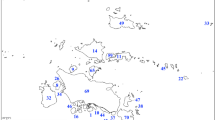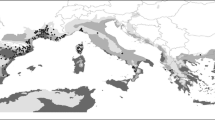Abstract
Our knowledge of the spatial distribution of bryophyte diversity still suffers from low sampling efforts. Here we try to determine the spatial diversity patterns of liverworts and mosses and their environmental drivers more accurately by correcting for this sampling bias. We compiled bryoflora from 49 localities in eastern China, including data on sampling effort. Both sampling bias uncorrected (raw) species richness and bias corrected (estimated) species richness, as derived from species-sampling curves, were used as response variables. Model selection based on Akaike’s information criterion was used to evaluate the impact of collection bias on the selection of environmental and spatial variables in the regression models. Variation partitioning was used to assess the independent and joint effects of environmental, spatial and sampling variables on raw and estimated species richness. Liverwort richness increased significantly with decreasing latitude, while moss richness showed no latitudinal pattern, whether for raw or estimated species richness. However, estimated species richness showed stronger correlation with environmental variables than raw species richness. Importantly, selected environmental variables in the raw species richness models changed after correcting for collection bias. Despite their ability to produce copious amounts of spores, our sampling bias corrected models indicated that bryophyte richness showed strong spatial structuring, indicating dispersal limitation. Environmentally, liverwort richness was primarily controlled by water availability, while the richness of mosses was mainly determined by available energy. Our results highlight that biological features, dispersal ability and environmental sorting may account for the discrepancies between species richness of liverworts and mosses. Given the considerable impact that controlling for sampling effort had on analysis outcome, we like to stress the importance of controlling for sampling bias when studying spatial richness patterns in bryophytes.



Similar content being viewed by others
References
Alpert P (1979) Desiccation of desert mosses following a summer rainstorm. Bryologist 82:65–71
Aranda SC, Gabriel R, Borges PA, Lobo JM (2010) Assessing the completeness of bryophytes inventories: an oceanic island as a case study (Terceira, Azorean archipelago). Biodivers Conserv 19:2469–2484
Arrhenius O (1921) Species and area. J Ecol 9:95–99
Beck J, Ballesteros-Mejia L, Buchmann CM, Dengler J, Fritz SA et al (2012) What’s on the horizon for macroecology? Ecography 35:673–683
Borcard D, Legendre P (2002) All-scale spatial analysis of ecological data by means of principal coordinates of neighbour matrices. Ecol Model 153:51–68
Chen SB, Jiang GM, Ouyang ZY, Xu WH, Xiao Y (2011) Relative importance of water, energy, and heterogeneity in determining regional pteridophyte and seed plant richness in China. J Syst Evol 49:95–107
Chen S, Mao L, Zhang J, Zhou K, Gao J (2014) Environmental determinants of geographic butterfly richness pattern in eastern China. Biodivers Conserv 23:1453–1467
Dray S, Legendre P, Peres-Neto PR (2006) Spatial modelling: a comprehensive framework for principal coordinate analysis of neighbour matrices (PCNM). Ecol Model 196:483–493
Dunn RR, Agosti D, Andersen AN, Arnan X, Bruhl CA et al (2009) Climatic drivers of hemispheric asymmetry in global patterns of ant species richness. Ecol Lett 12:324–333
During HJ, Van Tooren BF (1987) Recent developments in bryophyte population ecology. Trends Ecol Evol 2:89–93
Dutilleul P (1993) Modifying the t test for assessing the correlation between two spatial processes. Biometrics 49:305–314
Fenchel T, Finlay BJ (2004) The ubiquity of small species: patterns of local and global diversity. Bioscience 54:777–784
Field R, Hawkins BA, Cornell HV, Currie DJ, Diniz-Filho JAF et al (2009) Spatial species-richness gradients across scales: a meta-analysis. J Biogeogr 36:132–147
Finlay BJ (2002) Global dispersal of free living microbial eukaryote species. Science 296:1061–1063
Foissner W (2006) Biogeography and dispersal of micro-organisms: a review emphasizing protists. Acta Protozool 45:111–136
Fontaneto D, Brodie J (2011) Why biogeography of microorganisms? In: Fontaneto D (ed) Biogeography of microscopic organisms: is everything small everywhere. Cambridge University Press, Cambridge, pp 3–10
Frahm JP (2008) Diversity, dispersal and biogeography of bryophytes (mosses). Biodivers Conserv 17:277–284
Geffert JL, Frahm JP, Barthlott W, Mutke J (2013) Global moss diversity: spatial and taxonomic patterns of species richness. J Bryol 35:1–11
Glime JM (2007) Bryophyte ecology, Vol. 1. Physiological ecology. EBook sponsored by Michigan Technological University and the International Association of Bryologists. www.bryoecol.mtu.edu. Accessed Feb 2014
Gotelli NJ, Colwell RK (2010) Estimating species richness. In: Magurran AE, McGill BJ (eds) Biological diversity: frontiers in measurement and assessment. Oxford University Press, Oxford, pp 39–54
Grau O, Grytnes JA, Birks HJB (2007) A comparison of altitudinal species richness patterns of bryophytes with other plant groups in Nepal, Central Himalaya. J Biogeogr 34:1907–1915
Hijmans RJ, Cameron SE, Parra JL, Jones PG, Jarvis A (2005) Very high resolution interpolated climate surfaces for global land areas. Int J Climatol 25:1965–1978
Hu R (1990) Distribution of bryophytes in China. Trop Bryol 2:133–137
Jia Y, He S (2013) Species catalogue of China (volume 1: bryophytes). Science Press, Beijing
Jiang Y, de Bie CAJM, Wang T, Skidmore AK, Liu X et al (2013) Hyper-temporal remote sensing helps in relating epiphyllous liverworts and evergreen forests. J Veg Sci 24:214–226
Kier G, Mutke J, Dinerstein E, Ricketts TH, Küper W et al (2005) Global patterns of plant diversity and floristic knowledge. J Biogeogr 32:1107–1116
Medina NG, Draper I, Lara F (2011) Biogeography of mosses and allies: does size matter. In: Fontaneto D (ed) Biogeography of microscopic organisms: is everything small everywhere. Cambridge University Press, Cambridge, pp 209–233
Medina NG, Lara F, Mazimpaka V, Hortal J (2013) Designing bryophyte surveys for an optimal coverage of diversity gradients. Biodivers Conserv 22:3121–3139
Möls T, Vellak K, Vellak A, Ingerpuu N (2013) Global gradients in moss and vascular plant diversity. Biodivers Conserv 22:1537–1551
Mutke J, Geffert JL (2010) Keep on working: the uneven documentation of regional moss floras. Trop Bryol 31:7–13
O’Malley MA (2007) The nineteenth century roots of ‘everything is everywhere’. Nat Rev Microbiol 5:647–651
Oliver M, Tuba Z, Mishler BD (2000) The evolution of vegetative desiccation tolerance in land plants. Plant Ecol 151:85–100
Patiño J, Guilhaumon F, Whittaker RJ, Triantis KA, Gradstein SR et al (2013) Accounting for data heterogeneity in patterns of biodiversity: an application of linear mixed effect models to the oceanic island biogeography of spore-producing plants. Ecography 36:904–913
Peres-Neto PR, Legendre P, Dray S, Borcard D (2006) Variation partitioning of species data matrices: estimation and comparison of fractions. Ecology 87:2614–2625
Pócs T (1996) Epiphyllous liverworts diversity at worldwide level and its threat and conservation. An Inst Biol Univ Nac Auton Mex Bot 67:109–127
Porley R, Hodgetts N (2005) Mosses and liverworts. Harper Collins, London
Proctor MC, Oliver MJ, Wood AJ, Alpert P, Stark LR et al (2007) Desiccation-tolerance in bryophytes: a review. Bryologist 110:595–621
Qiu YL, Cho Y, Cox JC, Palmer JD (1998) The gain of three mitochondrial introns identifies liverworts as the earliest land plants. Nature 394:671–674
Quinn GP, Keough MJ (2002) Experimental design and data analysis for biologists. Cambridge University Press, Cambridge
Rangel TFLVB, Diniz-Filho JAF, Bini LM (2006) Towards an integrated computational tool for spatial analysis in macroecology and biogeography. Glob Ecol Biogeogr 15:321–327
Rangel TFLVB, Diniz-Filho JAF, Bini LM (2010) SAM: a comprehensive application for spatial analysis in macroecology. Ecography 33:46–50
Rice SK, Collins D, Anderson AM (2001) Functional significance of variation in bryophyte canopy structure. Am J Bot 88:1568–1576
Shaw AJ, Cox CJ, Goffinet B (2005) Global patterns of moss diversity: taxonomic and molecular inferences. Taxon 54:337–352
Telford RJ, Vandvik V, Birks HJB (2006) Dispersal limitations matter for microbial morphospecies. Science 312:1015
Vanderpoorten A, Engels P (2003) Patterns of bryophyte diversity and rarity at a regional scale. Biodivers Conserv 12:545–553
Vanderpoorten A, Goffinet B (2009) Introduction to bryophytes. Cambridge University Press, Cambridge
Virtanen R (2014) Diaspore and shoot size as drivers of local, regional and global bryophyte distributions. Glob Ecol Biogeogr 23:610–619
von Konrat M, Renner M, Söderström L, Hagborg A, Mutke J (2008) Chapter nine: early land plants today: liverwort species diversity and the relationship with higher taxonomy and higher plants. Fieldiana Bot 47:91–104
Whittaker RH (1972) Evolution and measurement of species diversity. Taxon 21:213–251
Willig MR, Kaufman DM, Stevens RD (2003) Latitudinal gradients of biodiversity: pattern, process, scale, and synthesis. Annu Rev Ecol Evol Syst 34:273–309
Willott SJ (2001) Species accumulation curves and the measure of sampling effort. J Appl Ecol 38:484–486
Wood AJ (2007) The nature and distribution of vegetative desiccation-tolerance in hornworts, liverworts and mosses. Bryologist 110:163–177
Yang W, Ma K, Kreft H (2013) Geographical sampling bias in a large distributional database and its effects on species richness–environment models. J Biogeogr 40:1415–1426
Zhang J, Nielsen SE, Grainger TN, Kohler M et al (2014) Sampling plant diversity and rarity at landscape scales: importance of sampling time in species detectability. PLoS ONE 9:e95334. doi:10.1371/journal.pone.0095334
Zhu RL, So ML (2001) Epiphyllous liverworts of China. Nova Hedwig 121:1–418
Acknowledgments
We thank financial support from the National Key Technology R&D Program (2012BAC01B08) and the Special Public Science and Technology Research Program for Environmental Protection (201209027).
Author information
Authors and Affiliations
Corresponding author
Additional information
Communicated by Dirk Sven Schmeller.
Electronic supplementary material
Below is the link to the electronic supplementary material.
Rights and permissions
About this article
Cite this article
Chen, S., Ferry Slik, J.W., Mao, L. et al. Spatial patterns and environmental correlates of bryophyte richness: sampling effort matters. Biodivers Conserv 24, 593–607 (2015). https://doi.org/10.1007/s10531-014-0838-8
Received:
Revised:
Accepted:
Published:
Issue Date:
DOI: https://doi.org/10.1007/s10531-014-0838-8




